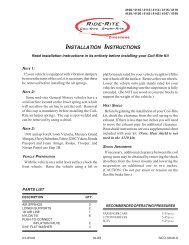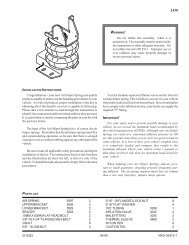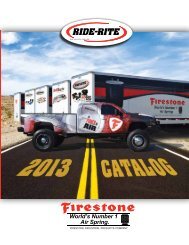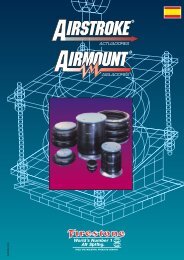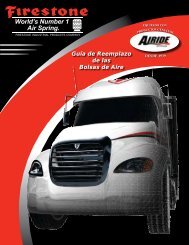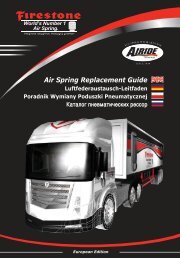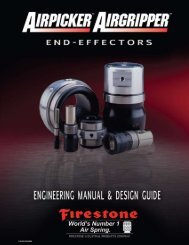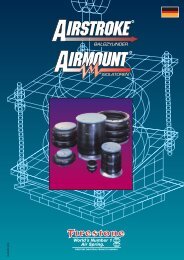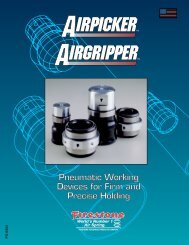BUS 014 - Firestone Industrial Products
BUS 014 - Firestone Industrial Products
BUS 014 - Firestone Industrial Products
You also want an ePaper? Increase the reach of your titles
YUMPU automatically turns print PDFs into web optimized ePapers that Google loves.
Airide<br />
springs<br />
1T-Reversible<br />
Sleeve Style<br />
Extended height<br />
Collapsed height<br />
The <strong>Firestone</strong> 1T or Reversible Sleeve type spring is the<br />
most popular style used on bus suspensions. Most of your<br />
replacement work will probably be with this style.<br />
Identification of the proper replacement assembly requires<br />
identifying the bellows type and the bead plate and piston<br />
type used, as well as whether the spring includes an internal<br />
rubber bumper.<br />
As with other styles, the quickest way to identify the airspring<br />
is to read the manufacturer or <strong>Firestone</strong> order<br />
number on the bead plate. If the number is illegible, read the<br />
part number molded on the bellows, normally directly under<br />
the firestone name. This will lead you directly to the proper<br />
section of this guide, narrowing your choice of assemblies to<br />
just a few.<br />
Stud<br />
Bead plate<br />
Bellows<br />
Air entrance<br />
Tapped hole<br />
Service<br />
Assembly<br />
Should the bellows number be unreadable, the type can still<br />
be determined by measuring the extended height of the<br />
bellows. To do this, remove the air entrance and then<br />
measure the height as shown. Compare this measurement<br />
with the maximum height shown in the “Cross Section View”<br />
in the parts tables, until you find the bellows style that<br />
agrees with it.<br />
To determine whether the spring has an internal bumper,<br />
remove the air and compress the spring to its minimum<br />
collapsed height. Measure this, as shown, and contact<br />
your distributor or <strong>Firestone</strong> to determine if a rubber<br />
bumper exists.<br />
Finally, to complete identification of the assembly, carefully<br />
compare the bead plate and piston with those listed in the<br />
tables until you find a match. Detailed explanations of the<br />
types of bolts, studs, and air fittings used on the bead plate<br />
can be found on page 4 of this guide.<br />
Service Assembly<br />
The 1T style spring is available as either a complete<br />
assembly, including the piston, or as a service assembly,<br />
which includes the bellows and bead plate only. Before you<br />
order a service assembly only, we advise close inspection of<br />
the piston to be reused. A slight imperfection or build-up of<br />
corrosion or dirt on the piston may cause a new bellows to<br />
wear out prematurely.<br />
Washer<br />
Bolt<br />
Piston<br />
Special Note<br />
Further information on pistons used with 1T style<br />
springs can be found in the Cross Reference section,<br />
pages 34 and 35.<br />
In addition to the center attaching hole, all newer pistons<br />
have four threaded holes in the outer diameter to make the<br />
piston more universal. All of the outer holes may not be used<br />
in some cases. Check the drawing of the assembly you are<br />
replacing to be sure.<br />
Some pistons are also supplied with threaded studs inserted<br />
in the proper mounting holes on the piston. Be certain to<br />
check the listings for this feature, too.<br />
10



